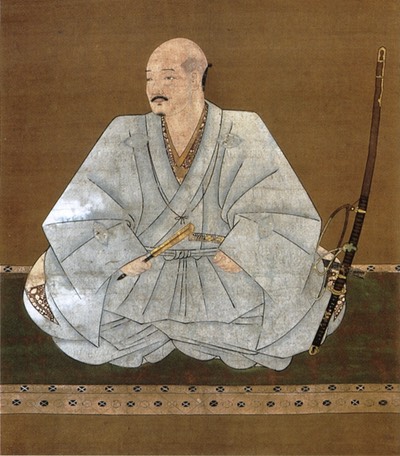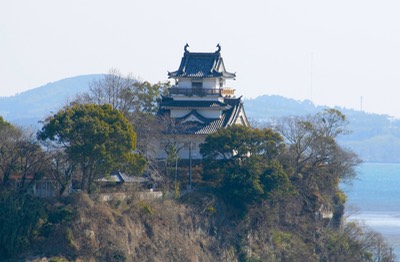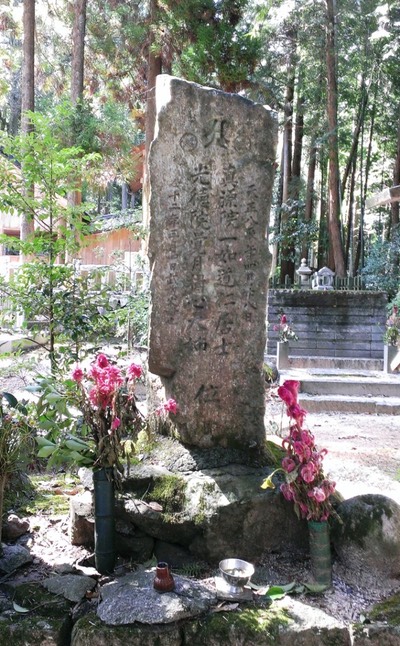Most of the records on Musashi agree that he was the son of a scion of the Shinmen, who went either by the name of Muni or Munisai. Thus the Kokura hibun, the epitaph on the huge stone monument erected in Kokura by Musashi's son, Iori, declared that the “name of his father, Shinmen, who came from a house known for its mastery of the jitte, was Muni.” Similarly, the Honchō bugei shoden (1714) states that Musashi's father “was called Shinmen Munisai and was an adept in the art of the jitte.”
The Tōsakushi (also see Musashi's Birthplace) is the first record to claim that Muni’s original name was Hirata. It is clear how its author, Masaki Teruo, arrived at this conclusion. Delving around in local historical records related to the Shinmen clan the historian soon found that a samurai by the name of Muni had been in the service of the Shinmen, but that his own clan's name was not Miyamoto, but Hirata. Thus a warrior by the name of Hirata Muni makes his appearance in the Shinmen kaki, the local record of the Shinmen clan, which Teruo had already uncovered and transcribed earlier in his career:
天正六年春、草刈太郎左衛門重継猶以新免一族と数度合戦し...平田無二槍を入るゝ所に、草刈が勢引包ミ無二を打とらんと七人して鑓を付るを、平田手利にて即座に敵の鑓をからみ付、敵三人迄突留、首を取、殘る敵を追散らすにより、草刈敗軍す。
In the summer of the sixth year of the Tenshō era [1578] Kusakari Tarōemon Shigetsugu and others met in battle with the Shinmen clan several times...and when Hirata Muni advanced with his yari, seven warriors among the enemy sought to strike Muni down with their yari, but Hirata skillfully took hold of their yari, running down as many as three enemy warriors, taking their heads, and giving chase to the remainder, thereby defeating the Kusakari forces.
Muni, then, was a retainer of the Shinmen. Leader of the Shinmen clan at Muni's time was Shinmen Munetsura, the master of Takeyama castle in the province of Mimasaka. Early in 1554, the domains of Munetsura's father, Munesada, had been overrun by the forces of Amago Haruhisa (1514–1561), who at that time controlled no less than eight of Honshu’s western provinces. Over the next few decades his father had made several attempts to recover what they had lost, but all of their efforts proved abortive. Dispossessed and disillusioned Munesada had passed away in 1558. The care of Munetsura, who was still in his infancy, was taken over by his uncle.
By the time Munetsura had come of age, however, the fortunes of the Shinmen were again waxing. Their first brake came with the death, in 1562, of Amago Hiruhisa and then, in 1566, with the fall of their Amago stronghold of Tomida castle. Becoming enfeoffed to the powerful warlord Ukita Naoie, Munetsura gradually restored the standing of his clan in the region so that during the eighties and nineties, the Shinmen held possessions in the Yoshino district totaling some five thousand koku, had some sixty samurai in their service, and employed close to two hundred men and women.
It was during those years that Munetsura served under Ukita Hideie, who had succeeded his father in 1582, in Toyotomi Hideyoshi’s campaign to unify the country, as well as the two Korean campaigns during the nineties. And, it is during this period, in the year 1592, that Muni again makes his appearance in the Shinmen kaki:
木曽判官城へ備前中納言宇喜田秀家押寄るにより、新免伊賀守勢一ツに成て戦ひ、東南の石垣を引崩す。夫より諸国勢乗込、新免方ニ而ハ社十右衛門、平田無二、新免備後、大原家より春名の一族、一番に乗込、首三十六取。
When Bizen Chūnagon Ukita Hideie laid siege of Hōgan castle of the Kisō clan, Shinmen Iga no Kami [Munetsura] joined forces and made battle, breeching the castle's wall on the south east. [Hideie]'s forces now stormed in, among them Hassha Jūemon, Hirata Muni, Shinmen Higo, and all the Haruna men from the Oohara clan were the first in, taking thirty six heads.
Having proved himself in battle Muni steadily climbed in rank until, sometime during the early eighties, he had reached the position of commander in charge of some fifty warriors. It was probably around this time, too, that he married Munetsura's sister (see Musashi's Mother), Omasa, for not long afterwards, in 1584, they had their first (and only) son, whom they gave the name Bennosuke and who would on to become the one of Japan's most famous swordsman, Miyamoto Musashi.
If the Shinmen kaki is correct, then, Muni was still in the service of Shinmen Munetsura around the early 1590s. This is supported by other records, in particular the Tōsakushi, as well as the Mimasaka taiheiki, a record of the Kan clan from the Tatsuta district of Mimasaka compiled around the middle of the nineteenth century by a certain Minagi Yasuzane.
What is certain is that by the turn of the century Muni had entered the service of the Kuroda clan. In it’s opening paragraph the Bushū denraiki clearly states that Muni "was in the service of Kuroda Toshitaka, a brother of Kuroda Yoshitaka.” Thought he contributed to his older brother’s campaign to subdue Kyushu, Toshitaka seems to have had a frail constitution, for he died off the battlefield in 1596 at the age of only forty-two. Muni, who at this stage would have lived at Toshtaka’s stronghold of Takamori, remained in the service of the Kuroda clan, right up until the Battle of Sekigahara.
That much, at least, is borne out by the Keichō nenchū samurai-chū jija chigyō (1604). In that document he is listed as a furugo fudai, or an long-standing hereditary vassal, which means that Muni had entered the service of the Kuroda before 1600, the year in which the Kuroda were promoted to their new estate in Chikuzen. Muni, in other words, had entered the service of the Kuroda before the Battle of Sekigahara. He can, therefore, not have taken part in that battle under Munetsura as many (including Youshikawa Eiji) would have us believe. He would now have moved to the port of Nakatsu (see Nakatsu Port).
It was no coincidence that Muni should have entered the service of Toshitaka. Though the Kuroda originally hailed from the province of Bizen, both Yoshitaka and his brother Toshitaka had been born in Himeji castle. And though they had belonged to different factions during the seventies, with Hideyoshi’s rise during the eighties, both the Shinmen and the Kuroda had fought in Hideyoshi’s campaigns to pacify the country. Indeed, it might well have been during Hideyoshi’s first invasion of Korea, when Yoshitaka served as Ukita Hideie’s commanders in the field, that Muni impressed Yoshitaka’s recruiters.
In old age, probably somewhere during the first decade of the seventeenth century, Muni, retired from active duty. He took the tonsure and took on the spiritual name of Munisai. He also moved again, this time to Kitsuki, in Bungō, where he lived in a small retreat on the edge of the small castle town, spending his last days in perfecting his Tōri-ryū. He did so on the invitation of Lord Matsui Yasuyuki, master of Kitsuki castle, and a vassal to the powerful Hosokawa clan. Yasuyuki's son, Nagaoka (Matsui) Okinaga, who had known and befriended Musashi at the time of the latter's duel with Sasaki Kojirō, would also play an important role in Musashi's life when he too had become an old man and taken up residence in Kumamoto on the invitation of Hosokawa Tadatoshi (1586–1641). Not surprisingly, it was a retainer of the Nagaoka who, more than a century later, was to write the Bukōden, one of the first full biographies of Miyamoto Musashi.
One of the local chieftains to invite Muni for practice was the daimyō Kinoshita Nobutoshi, the master of Hiji castle, situated a few miles southward along the coast from the port of Kitsuki. Fortunately Nobutoshi kept a day-to-day diary during most of 1613, and it is from his diary, the Keichō nikki, that it emerges that in the spring of that year, Munisai frequently visited Hiji castle. Thus the entry for May 2 [June 19], records how, “though it had been raining since morning, Munisai came round at four o’clock.” The next day, the weather improves and that evening both warriors “went out and had diner together.” The dinner must have been a lavish affair, for two days later Nobutoshi was again visited by the swordsman “and was given two hats as a present.”
Muni probably died during the 1620s, though the date in unknown. Neither has his grave ever been found. The Tōsakushi mentions an old tombstone among the Jigami hills, above the old family yashiki in Miyamoto, and assumes it must mark Muni's grave (see Musashi Shrine). The grave, however, is ascribed to a certain Buni (武二), and not Muni (無二). The gravestone, then, does not mark the grave of Muni (who almost certainly died in Kyushu, probably in Kitsuki), but that of his father. That would make the most sense chronologically, for the date on the withered stone reads “eighteenth day of the fourth month of the eighth year of the Tenshō era [May 31, 1580].
Though the Tōsakushi seems to explain the source of the name Shipmen in Musashi’s unabbreviated name, it is at the same time one of the most contentious aspects in the reconstruction of Musashi’s life, for it means that Musashi must almost certainly have been born in the village of Miyamoto in the district of Yoshino in the province of Mimasaka, and that he was therefore not a native of the province of Harima.
Any queries of remarks? Launch or join a discussion at our new FORUM


